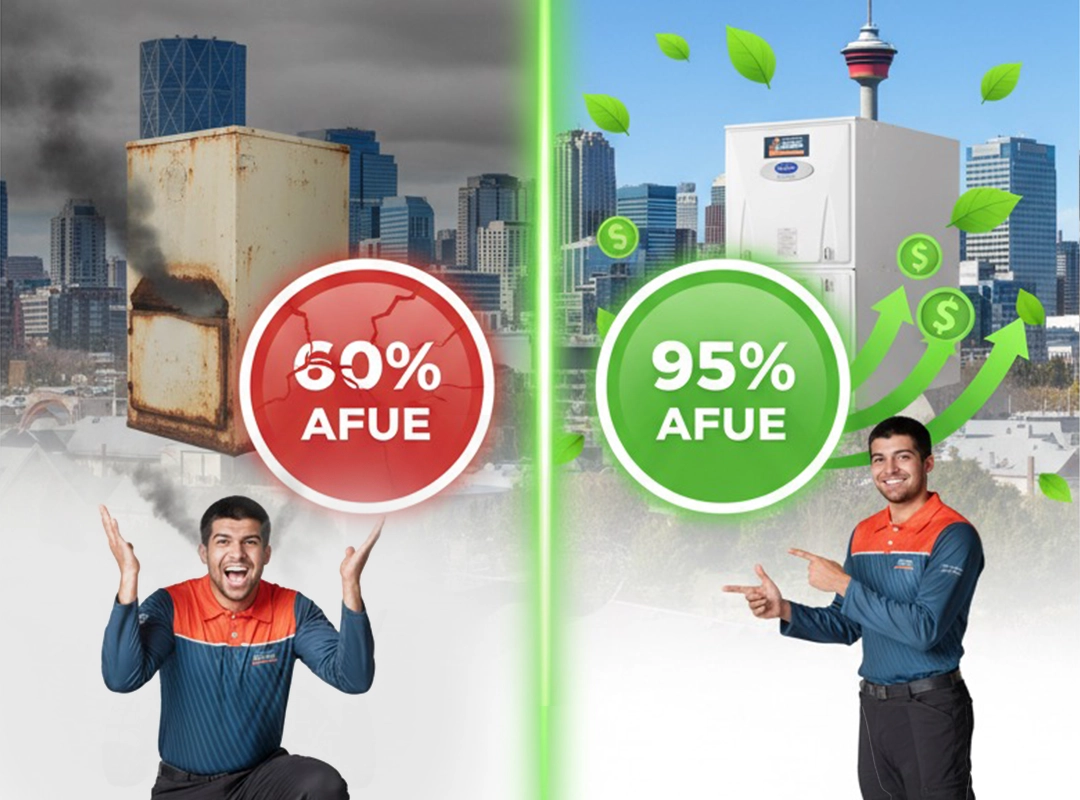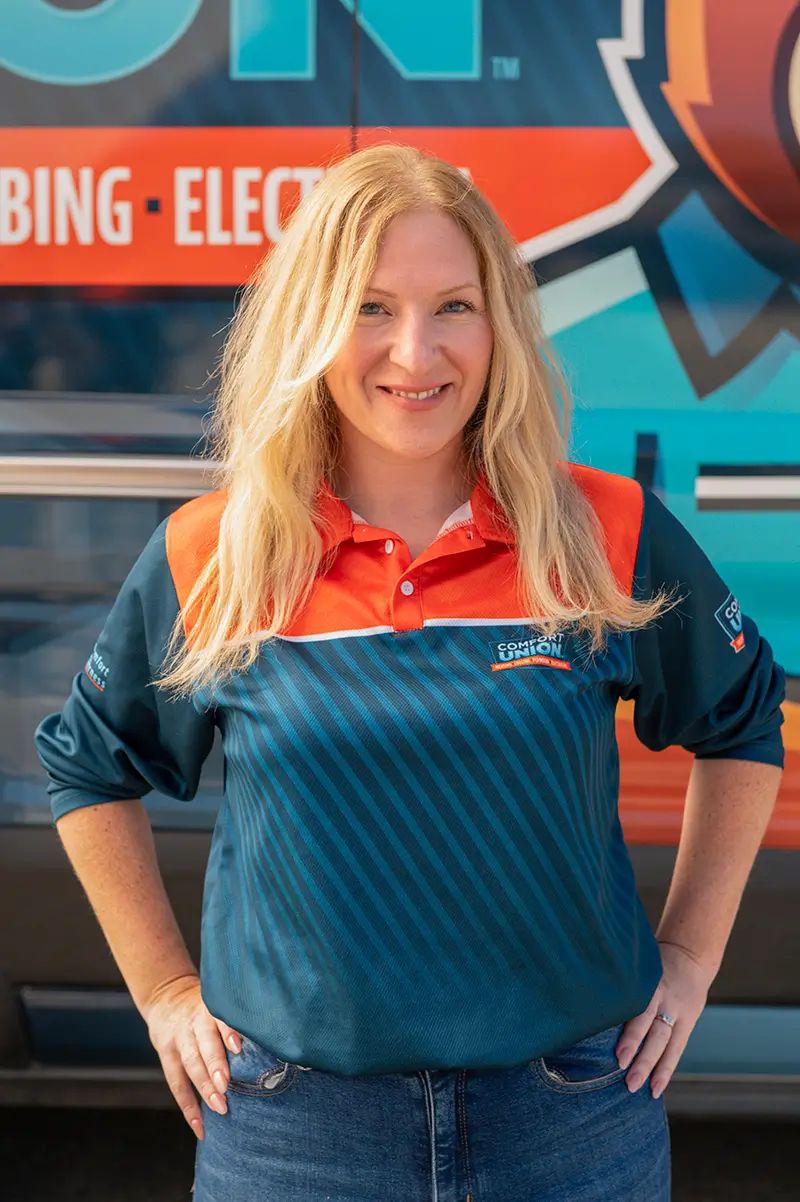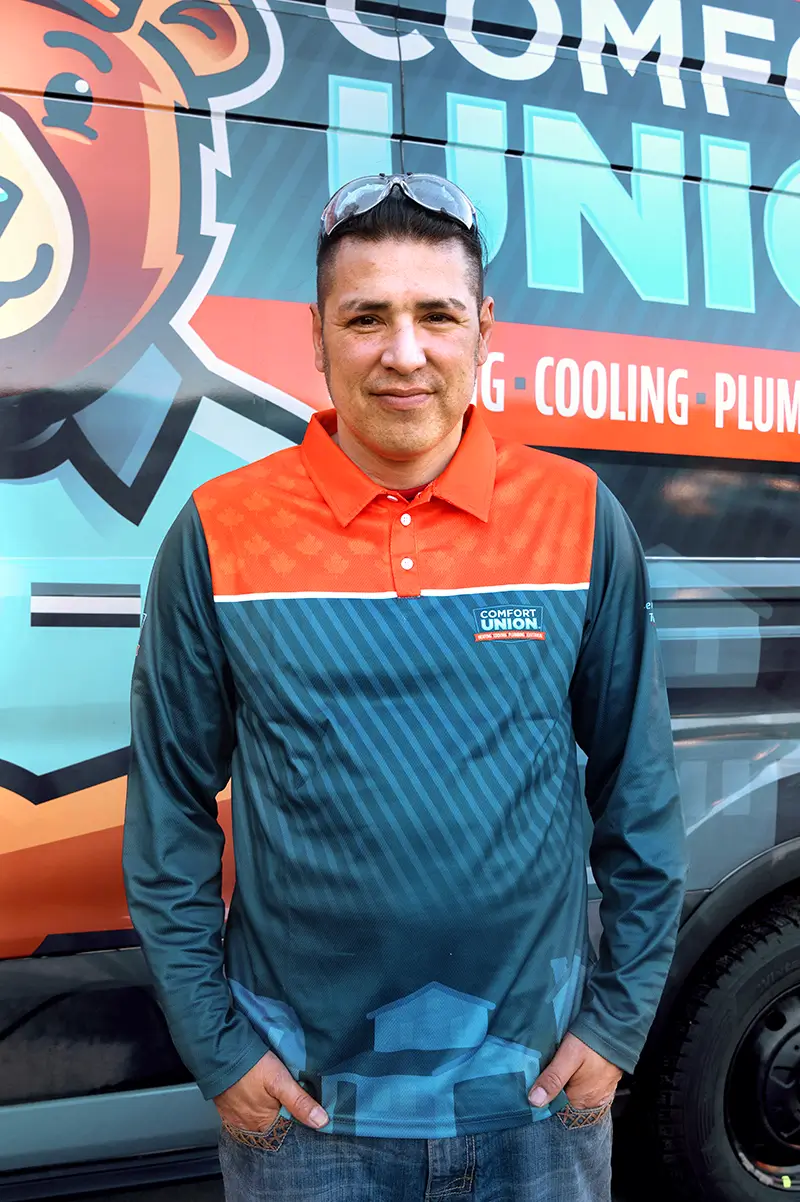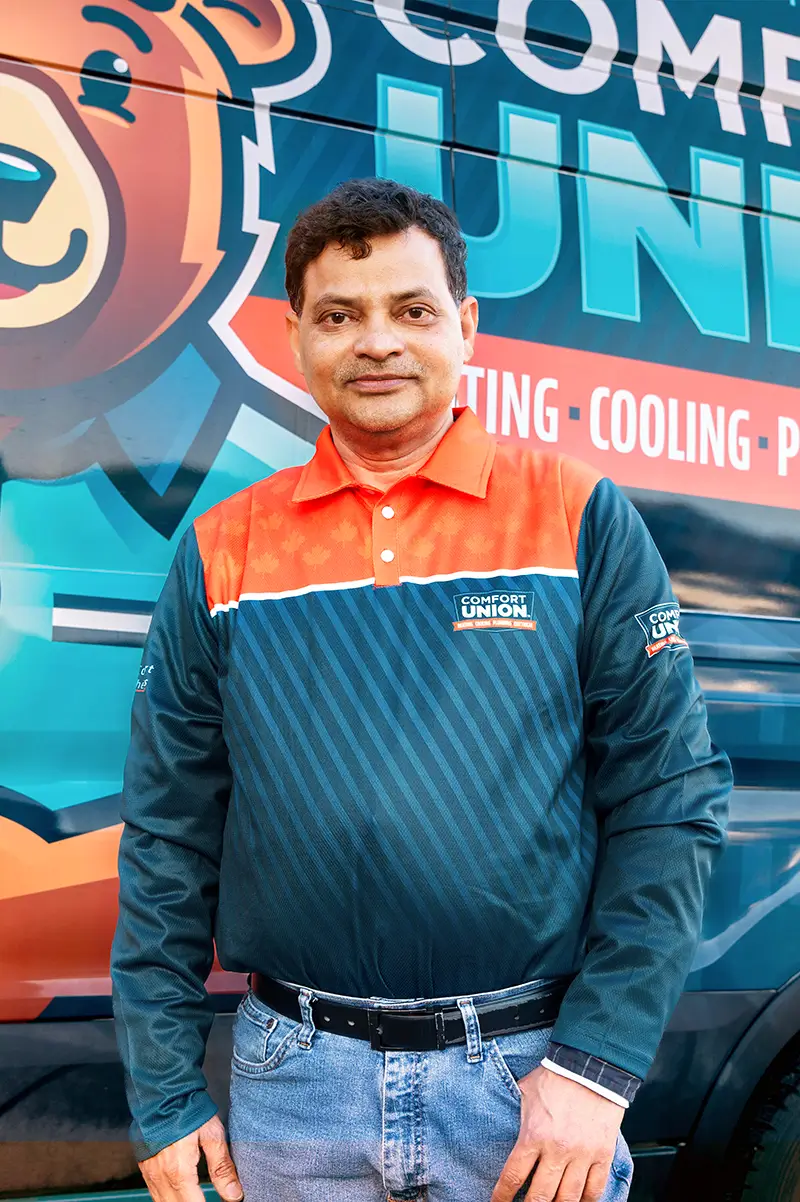If you’ve ever shopped for a new furnace, you’ve probably seen the term AFUE rating pop up on product labels and wondered what it means. In simple terms, AFUE, or Annual Fuel Utilization Efficiency, tells you how efficiently your furnace converts fuel into usable heat. The higher the number, the less energy (and money) goes up your vent pipe. In places like Calgary, where furnaces run for six to eight months straight, that small percentage difference can mean real savings over time.
This guide will help you understand what AFUE really means, how it affects your energy bills, and what to look for when choosing the right furnace for your Alberta home.
Need a New Furnace?
With Flexible Financing Options
Understanding AFUE: Definition, Formula & Real Meaning
AFUE stands for Annual Fuel Utilization Efficiency, and it’s expressed as a percentage. The formula is simple:
AFUE = (Heat Output ÷ Fuel Input) × 100.
So, if a furnace converts 95% of its fuel into heat for your home, that means only 5% escapes through the exhaust or flue.
AFUE differs from “thermal efficiency,” which measures how well a furnace performs in ideal lab conditions. AFUE considers real-world factors like cycling on and off, heat loss during operation, and ventilation. That’s why it’s a more practical number for homeowners comparing systems.
Typical AFUE ranges look like this:
- 60–80%: Older, non-condensing furnaces (common in homes built before 2000).
- 90–95%: Standard high-efficiency furnaces available today.
- 96–99%: Modern condensing furnaces that recover heat from exhaust gases.
While manufacturers test AFUE in controlled environments, real-world numbers may be a bit lower depending on how your home’s ducts, vents, and insulation perform.
Why Does AFUE Have Matter in Calgary?
Furnace efficiency plays a major role in how well your home stays warm during Calgary’s long winter season. Understanding how efficiency works helps you choose a system that lowers bills, improves comfort, and keeps your furnace from overworking when temperatures drop.
1. Furnace efficiency matters more in Calgary’s long winters
Calgary’s cold season stretches across half the year, so the efficiency of your furnace plays a major role in overall comfort and cost. A higher AFUE furnace reduces how hard your system works during constant daily heating from October to April.
2. High AFUE models help stabilize heating bills
Because natural gas prices in Alberta can shift, efficient furnaces help keep monthly bills predictable. A 95 percent AFUE unit wastes very little fuel, which can save homeowners hundreds of dollars each winter.
3. Real home conditions can lower actual efficiency
AFUE numbers reflect perfect lab conditions, not drafty basements or older ductwork. Air leaks, blocked filters, and poor insulation can reduce true performance, which is why maintenance and proper home sealing are essential for real-world efficiency.
Choosing the Right AFUE For Your Home
Higher AFUE sounds great, but more efficiency also comes with a higher upfront price tag. The key is finding the balance between what you spend now and what you save later.
Here’s a quick guide:
- 92–94% AFUE: Great for smaller homes, tight budgets, or moderate use.
- 95–97% AFUE: The sweet spot for most Calgary homes, efficient, quiet, and reliable.
- 98–99% AFUE: Ideal for new builds or homeowners planning to stay long-term who want the lowest energy costs possible.
For example, upgrading a Calgary home from an old 80% furnace to a 95% model can save roughly 15% on annual heating bills. Depending on your home’s size and gas prices, the payback period usually falls within five to ten years.
If you plan to move soon, a mid-range furnace might make more financial sense. But if you’re settled in for the long haul, that extra efficiency quickly pays for itself.
What Factors Influence Effective Efficiency?
Even the most efficient furnace can’t perform well if the rest of your system isn’t in good shape. Think of AFUE as the engine, and your home as the car, it all needs to work together. Proper furnace installation really matters in this context.
Poorly sealed ducts, uninsulated basements, or undersized venting can waste a surprising amount of heat. Adding a variable-speed blower or modulating gas valve can further improve comfort and efficiency by matching your furnace’s output to your home’s heating demand.
Proper sizing also matters. A furnace that’s too big will short-cycle, while one that’s too small will run constantly, driving up wear and tear. Annual tune-ups and clean filters keep the system running at its best, ensuring your AFUE rating isn’t just a number on paper.
What Are AFUE Regulations in Canada?
In Canada, furnaces are regulated by Natural Resources Canada (NRCan) under the EnerGuide program, which makes comparing AFUE ratings easy. Look for the yellow EnerGuide label, it shows your furnace’s efficiency rating alongside the range for similar models.
As of 2023, the minimum national standard for new gas furnaces in Canada is 95% AFUE. Most brands now exceed that threshold, offering condensing models that recover more heat from exhaust gases. You can confirm this information through trusted sources like Natural Resources Canada.
In Alberta, there are occasionally provincial rebates for upgrading to energy-efficient systems. Local programs vary year to year, so it’s worth asking your installer or checking your utility provider’s website.
Upgrading From 80% to 95% AFUE in a Calgary Home
Let’s say you have an older 80% AFUE furnace that uses about $1,600 worth of natural gas each year. That means $320 of your energy literally goes up the vent.
Now, imagine replacing it with a 95% AFUE furnace. Only 5% of that energy is wasted, saving roughly $250 to $300 annually. Over 10 years, that’s $2,500–$3,000 back in your pocket, not to mention quieter operation, better airflow, and more consistent warmth across your home.
These savings can be even higher for larger Calgary homes, where the furnace runs longer and harder through the cold months.
For more details about what to look for in a furnace, check out our full buying guide.
Frequently Asked Questions
Is a 96% furnace better than an 80% furnace?
Yes, but the real question is by how much. A 96% furnace wastes far less energy, saving you about 15–20% on heating costs each year. It also runs quieter and produces more even heat throughout your home.
Is a 95% furnace worth the extra money?
For most Alberta homeowners, absolutely. With our long winters, the fuel savings add up quickly. Over several years, the initial investment often pays for itself through lower bills.
What does 95% AFUE mean?
It means 95% of the fuel your furnace burns turns into heat for your home, while 5% escapes through the exhaust. Higher numbers mean less waste and lower costs.
What is the difference between an 80% efficient furnace and a 90% efficient furnace?
An 80% furnace vents more heat outdoors, while a 90% or higher model captures that energy using a secondary heat exchanger. The result is a warmer home with less gas burned each season.
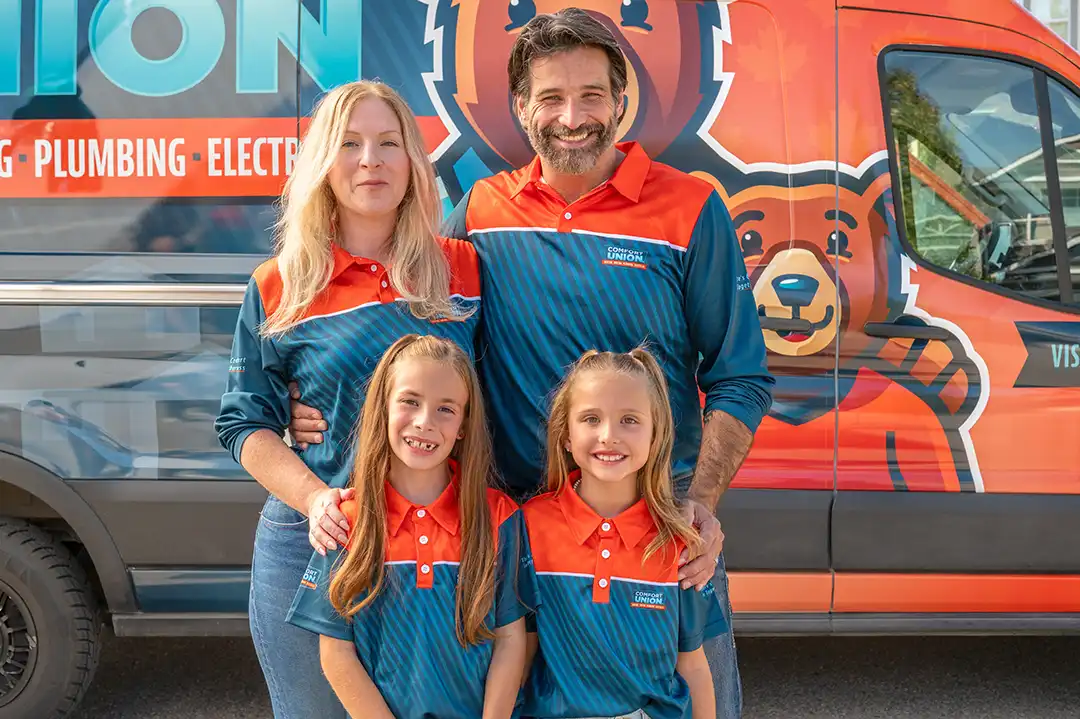
Fast, reliable furnace repair in Calgary. We diagnose and fix all makes and models to restore your home’s warmth quickly and safely.

Keep your system running smoothly with a professional furnace tune-up in Calgary. We clean, inspect, and optimize for peak efficiency and safety.

Breathe easier with professional furnace duct cleaning in Calgary. Remove dust, debris, and allergens for cleaner air and better system performance.







